A Dangerous Idea in U.S. Army Strategic Culture
A soldier signing an AGM-114 Hellfire missile mounted upon a MQ-1C Gray Eagle at Bagram Air Base, Afghanstan.
A meme is a cultural item that is transmitted by repetition and replication in a manner analogous to the biological transmission of genes. Like every institution, the U.S. Army retains a strategic culture that shapes both ideas and behavior in an iterative fashion. Memes are the nascent beginning of a shift in enculturation. In “Welcome to the Post-Precision World,” Irvin Oliver highlights the development of a recent meme gaining momentum within the U.S. Army, particularly in the halls of its staff colleges and its concept development agencies. This meme comes from the general trend of advocates who feel pressed, mostly due to yet another cyclical reduction in force structure, to widen the continued relevance of land power with elaborate appeals. The problem with such arguments is they undermine the lasting credibility of land power, which we’ll return to after we examine Oliver’s ostentatious claim that can be summarized adequately with the following passage from his post:
While the exponential increase in accuracy and lethality of today’s weapons have increased the efficiency of our killing power, the ability to discriminate in its use has not kept pace. This fact makes landpower unique and indispensable in discussions on the use of force. In the application of force, landpower has the most precise rheostat and as populations move closer together and live in the complex terrain of urban areas, landpower will only grow in importance.
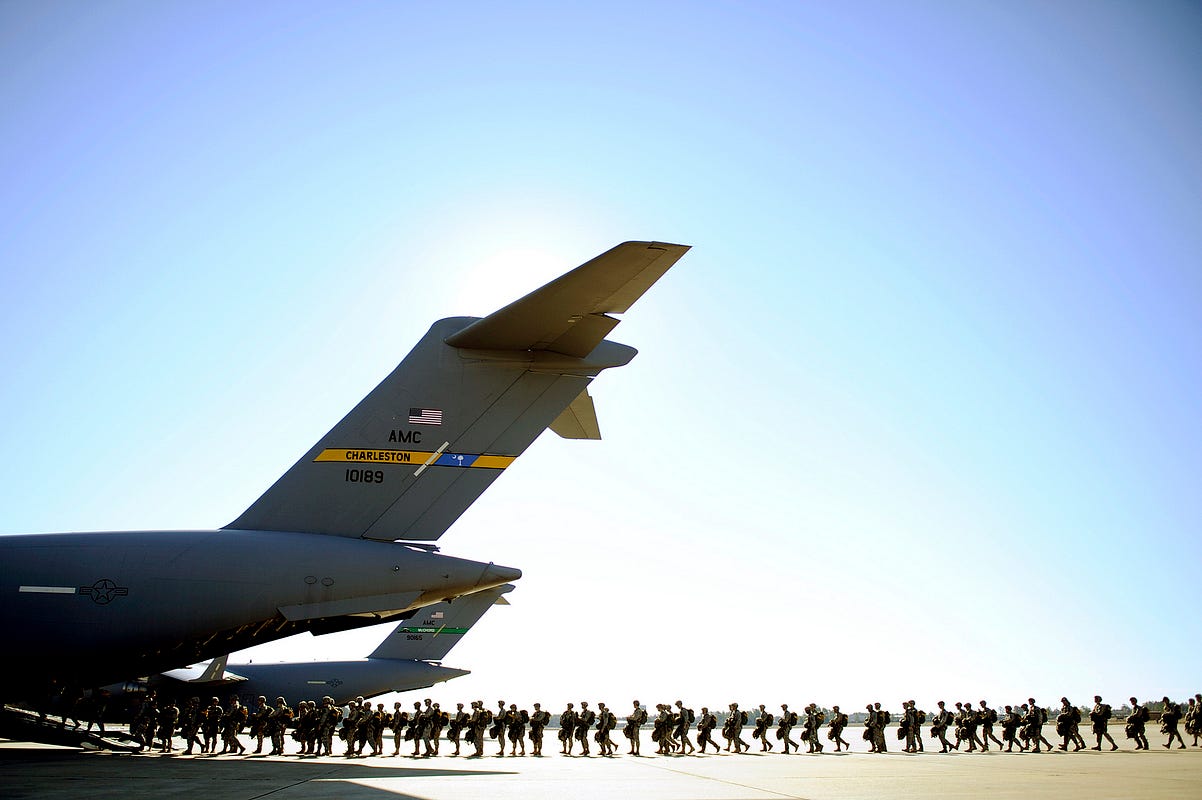 Paratroopers assigned to the 82nd Airborne Division prepare to board a C-17 Globemaster III Feb. 9, 2011, during a joint operational access exercise at Pope Air Force Base, N.C. (U.S. Air Force photo by Staff Sgt. Greg C. Biondo)
Paratroopers assigned to the 82nd Airborne Division prepare to board a C-17 Globemaster III Feb. 9, 2011, during a joint operational access exercise at Pope Air Force Base, N.C. (U.S. Air Force photo by Staff Sgt. Greg C. Biondo)
Oliver is generally correct about the indispensability of land power, but for the wrong reasons: land power does have unique strengths and it is indispensable in discussions on the use of force. However, at the strategic level, land power merely reflects the same nature as every other blunt object of coercion. Combined arms, and its most recent historical manifestation in joint arms, has always relied upon the complementary threat of the whole — even if that threat is only a latent one. This, in contrast, is an empirically sound judgment. As such, Oliver is baldly incorrect in the empirical proof of his argument for land power’s exceptional precision in the use of force. There are several reasons for this.
…the use of military force in every case is a blunt instrument of coercion; so it’s frivolous to suggest that one form or another is more discriminate at the strategic level.
First, and most importantly, the use of military power is never a precise scalpel in the hands of a highly tuned surgeon. It matters not from which method or domain the use of force comes. Rather, the use of military force in every case is a blunt instrument of coercion; so it’s frivolous to suggest that one form or another is more discriminate at the strategic level.
…tactical thinking is concerned with particular action and decisions, in this case the comparison between a bullet and a precision bomb, and strategic thinking is focused upon the aggregate interactions and holistic outcomes of the use of force.
Second, there is a conflation of tactical and strategic effect in the Oliver’s argument. Of course, it’s easy to be impressed by the idea that the individual bullet aimed by a highly-trained soldier is in fact the most precise instrument in the coterie of military effects, it is still a conflation of the tactical with strategic effect. Where tactical thinking is concerned with particular action and decisions, in this case the comparison between a bullet and a precision bomb, and strategic thinking is focused upon the aggregate interactions and holistic outcomes of the use of force.[1] The discernment of the soldier on the scene, that in some cases must differentiate their adversary against the background of bystanders may betactically precise, but in aggregate it may not matter at the strategic level.
…the mere presence of a soldier on the scene creates an imprecise destabilizing influence on the conflict.
Third, but by no means the last, is how the mere presence of a soldier on the scene creates an imprecise destabilizing influence on the conflict. The meme that land power is uniquely precise overlooks this basic fact and is primarily why its utilization demonstrates a significant form of escalation, because it will naturally attract resistance. As Daniel Grazier recently observed in his article, “Heisenberg and Mao Zedong: The Occupier Effect,” “[whatever] the circumstances that placed the soldier there, his presence will eventually be viewed as an outside intrusion into their affairs. This intrusion will breed resentment and given enough time, resentment will boil into violence.” Grazier relates this colloquially to the Heisenberg principle of uncertainty, and his analogy is apt, especially for a meme in which the soldier often sees the inexact influence of precision weapons as the causal influence in creating insurgency, while ignoring his/her own causality on the same.
In a world where observational bias and the Heisenberg principle exist, how can we trust Oliver when he suggests that “[direct], unfiltered observation is still often the best way to know and understand?” More importantly, how can one parse apart in strategic effect the influence of precision weaponry that unquestionably accompanies the influence of the soldier with the real possibility of confirmation bias or a mere preference for action? The truth is you cannot, at least not at the strategic level.
In terms of strategic effect, land power is no more precise than say air power, when they’re both equally blunt instruments of national power. Furthermore, if land power is so discriminate, why haven’t our recent stability operations in Iraq and Afghanistan resulted in more success?
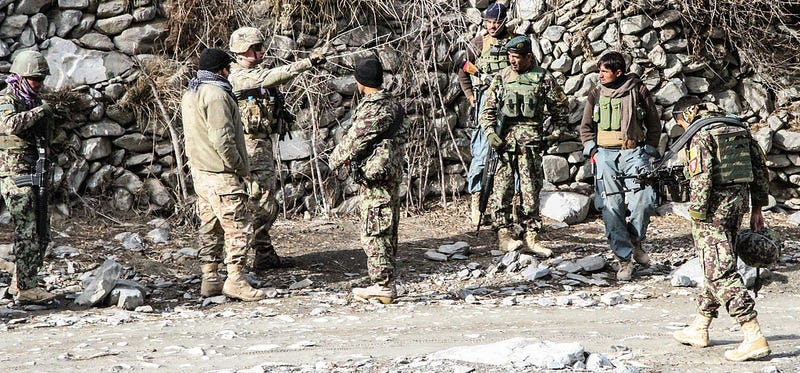 A U.S. Army Soldier discusses with Afghan National Army Soldiers the possible ways of conducting a mission in Nadir Shah Kot District, Afghanistan, Jan. 12, 2013. The mission was aimed at gathering information from village elders and to disrupt possible insurgent activity in the area. (Spc. Brian Smith-Dutton/U.S. Army)
A U.S. Army Soldier discusses with Afghan National Army Soldiers the possible ways of conducting a mission in Nadir Shah Kot District, Afghanistan, Jan. 12, 2013. The mission was aimed at gathering information from village elders and to disrupt possible insurgent activity in the area. (Spc. Brian Smith-Dutton/U.S. Army)
In terms of strategic effect, land power is no more precise than other forms, such as air power, as they’re both equally blunt instruments of national power. Furthermore, if land power is so discriminate, why haven’t our recent stability operations in Iraq and Afghanistan resulted in more success? The truth is, like Grazier suggests, sometimes a ‘stabilizing force’ is the primary source of instability, leading to a paradoxical circumstance for insurgency within war.[2]
Land power, despite its inherent uniqueness in asserting and exerting control, is in fact not monolithic. If you believe that land power is the pinnacle form of military power, as Oliver seems to when he states that it “is the central element of military power,” then you’re willfully ignoring the fact that the enemy gets a vote, and that guerrilla movements, insurgencies, and other forms of irregular warfare can effectively deny land power its control. If you believe that land power is uniquely discriminate in breaking the will of an adversary, you’ve simply not read enough history to know just how wrong you are.

A quick example might illuminate the point. Martin Windrow, in his remarkable book about Dien Bien Phu titled The Last Valleydescribed the difficulties of an occupying force, regardless of the specifics of the “human terrain” in which they might be involved:
The tension of constant vigilance, and the frustration of losing friends dead and maimed at the hands of an enemy who seldom showed himself, provoked a brutality towards civilians which simply increased Viet Minh support, and so multiplied the risk next time. Security operations sent the troops sweeping, often for weeks at a time, through village after village. They knew the Viet Minh were there, because the sniping, mining and booby-trapping were habitual; almost every day they had to carry back one or two bloody figures hanging in nets from shoulder poles. They knew the villagers knew where the Viet Minh were, because without the villagers’ knowledge the Viet Minh could not move, lie up or eat. They knew the Viet Minh would very seldom let themselves be surrounded and forced to fight it out, because the Viet Minh were far better informed than they were. It was these men who faced every day the classic dilemma of the counter-insurgency soldier: ‘I know that this wooden-faced peasant who won’t meet my eye and who is pretending not to understand me knows the man — perhaps it is the man — who laid the booby-trap which killed my friend yesterday, or which will kill me tomorrow; so how long can I endure his refusal to give me an excuse to strike back?’[3]
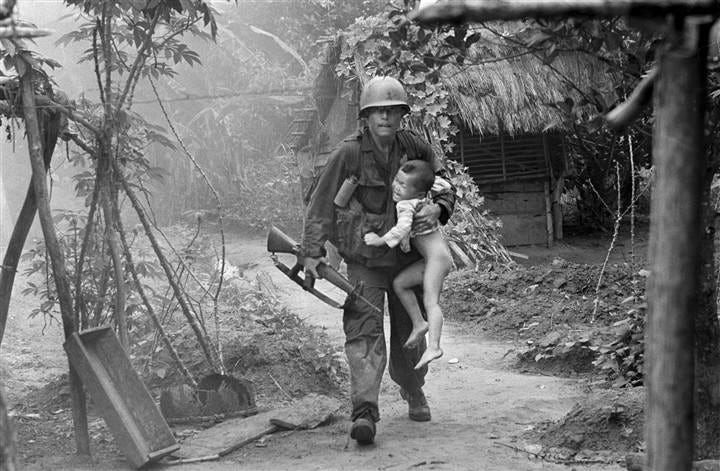 A U.S. infantryman from A Company, 1st Battalion, 16th Infantry carries a crying child from Cam Xe village after dropping a phosphorous grenade into a bunker cleared of civilians during an operation near the Michelin rubber plantation northwest of Saigon, August 22, 1966. A platoon of the 1st Infantry Division raided the village, looking for snipers that had inflicted casualties on the platoon. GIs rushed about 40 civilians out of the village before artillery bombardment ensued. (Via AP/NBCNews, Horst Faas)
A U.S. infantryman from A Company, 1st Battalion, 16th Infantry carries a crying child from Cam Xe village after dropping a phosphorous grenade into a bunker cleared of civilians during an operation near the Michelin rubber plantation northwest of Saigon, August 22, 1966. A platoon of the 1st Infantry Division raided the village, looking for snipers that had inflicted casualties on the platoon. GIs rushed about 40 civilians out of the village before artillery bombardment ensued. (Via AP/NBCNews, Horst Faas)
In the face of an adversary that can melt into the local populace, whether it be in the hinterlands of Vietnam, villages of Afghanistan like Khosrow Sofia or Tarok Kolache, or themegacities of the future, the idea of Oliver’s exceptionally “precise rheostat” of force folds under its own weight. And yet, this isn’t truly a knock on land power per se, but rather a reflection of the coercive nature of military power in general as a blunt instrument of policy.
Friction is equally inherent to all forms of military power.
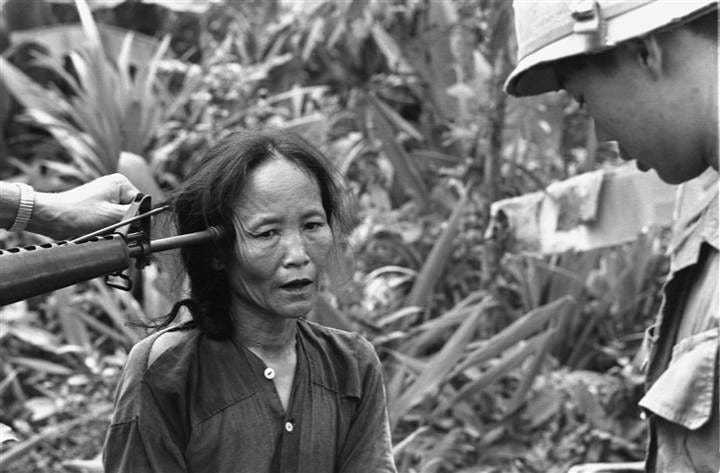 A female Viet Cong suspect is questioned at gunpoint by a South Vietnamese national police officer at Tam Ky, about 350 miles north of Saigon, November 1967. The M-16 rifle was held by a U.S. soldier during an operation of the 101st Airborne Brigade, searching villages of the coastal plains for suspected Viet Cong enclaves. (Via AP/NBCNews)
A female Viet Cong suspect is questioned at gunpoint by a South Vietnamese national police officer at Tam Ky, about 350 miles north of Saigon, November 1967. The M-16 rifle was held by a U.S. soldier during an operation of the 101st Airborne Brigade, searching villages of the coastal plains for suspected Viet Cong enclaves. (Via AP/NBCNews)
Despite Oliver’s correct point that the nature of war hasn’t changed, his belief that land power is truly more discriminate in a context like the Vendee or Vietnam in the past, Afghanistan today, or even in megacities of the future ignores the empirical fact of Clausewitzian friction. Friction is equally inherent to all forms of military power. Barry Watts in “Clausewitzian Friction and Future War” reminds us that “driving one’s own friction to zero while, simultaneously, rendering the enemy’s effectively infinite is not, at its core, a technical problem.”[4] There are real limits to how much a human can discern, cogitate, and consider action for, no matter how ideally you believe that soldiers “are able to contextualize and make sense of complex situations in a way electronic sensor, cameras, and satellites are still unable to.” Observation is still fraught with human frailty regardless of looking through a sensor or using the ‘Mark-1 Eyeball.’
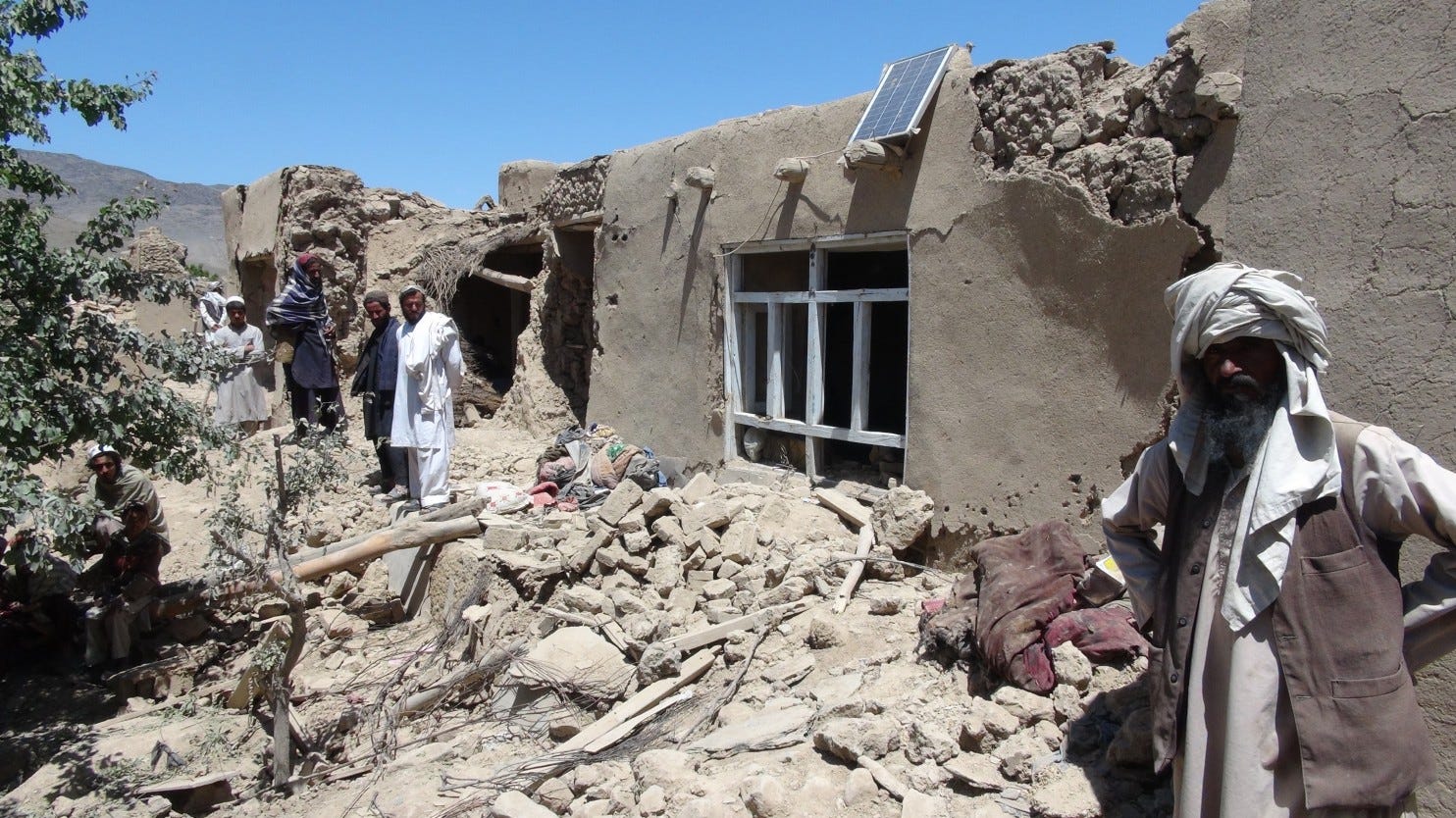 Afghan villagers gather near a house destroyed in a NATO raid in Logar province, south of Kabul, Afghanistan on June, 6, 2012. The airstrike was called in by U.S. troops after they came under fire while pursuing a Taliban fighter in a village in the Baraki Barak district. (Ihsanullah Majroh/AP) Like many insurgencies in the past, the Taliban utilize the well-worn tactic of shielding themselves amongst innocent civilians. In modern times, this has led to unfortunate loss of civilian life because of the moral hazard that occurs when friendly land forces are compelled in self defense to respond to enemy fire with firepower of their own. It is in this fashion where land power, and its associated usage of firepower in response to “troops in contact” event hardly result in discriminate application of force, or a “precise rheostat,” and thus it is just as capable of creating negative impacts upon strategic effect as the usage of other forms of military power. A Humans Right Watch report titled, “Troops in Contact,” states the following: “High civilian loss of life during airstrikes has almost always occurred during the fluid, rapid-response strikes, often carried out in support of ground troops after they came under insurgent attack. Such unplanned strikes included situations where US special forces units — normally small numbers of lightly armed personnel — came under insurgent attack; in US/NATO attacks in pursuit of insurgent forces that had retreated to populated villages; and in air attacks where US ‘anticipatory self-defense’ rules of engagement applied.”
Afghan villagers gather near a house destroyed in a NATO raid in Logar province, south of Kabul, Afghanistan on June, 6, 2012. The airstrike was called in by U.S. troops after they came under fire while pursuing a Taliban fighter in a village in the Baraki Barak district. (Ihsanullah Majroh/AP) Like many insurgencies in the past, the Taliban utilize the well-worn tactic of shielding themselves amongst innocent civilians. In modern times, this has led to unfortunate loss of civilian life because of the moral hazard that occurs when friendly land forces are compelled in self defense to respond to enemy fire with firepower of their own. It is in this fashion where land power, and its associated usage of firepower in response to “troops in contact” event hardly result in discriminate application of force, or a “precise rheostat,” and thus it is just as capable of creating negative impacts upon strategic effect as the usage of other forms of military power. A Humans Right Watch report titled, “Troops in Contact,” states the following: “High civilian loss of life during airstrikes has almost always occurred during the fluid, rapid-response strikes, often carried out in support of ground troops after they came under insurgent attack. Such unplanned strikes included situations where US special forces units — normally small numbers of lightly armed personnel — came under insurgent attack; in US/NATO attacks in pursuit of insurgent forces that had retreated to populated villages; and in air attacks where US ‘anticipatory self-defense’ rules of engagement applied.”
Land Power is Indispensable, the “Human Domain,” “Cognitive Dominance” are Not
Despite highlighting a deceptive meme of discrimination and rheostat precision in “Welcome to the Post-Precision World,” land power is still indispensable. The actual crux of the problem is the fact that many self-defeating land power advocates trend toward flashy rhetorical tricks rather than relying upon basic Clausewitzian truths and adequate historical insight. The implication that land power is inherently dominant in the so-called “Human Domain,” or that it is uniquely able to mete out force in a most “precise rheostat” to achieve cognitive dominance, is striking language, yet absolute foolishness.
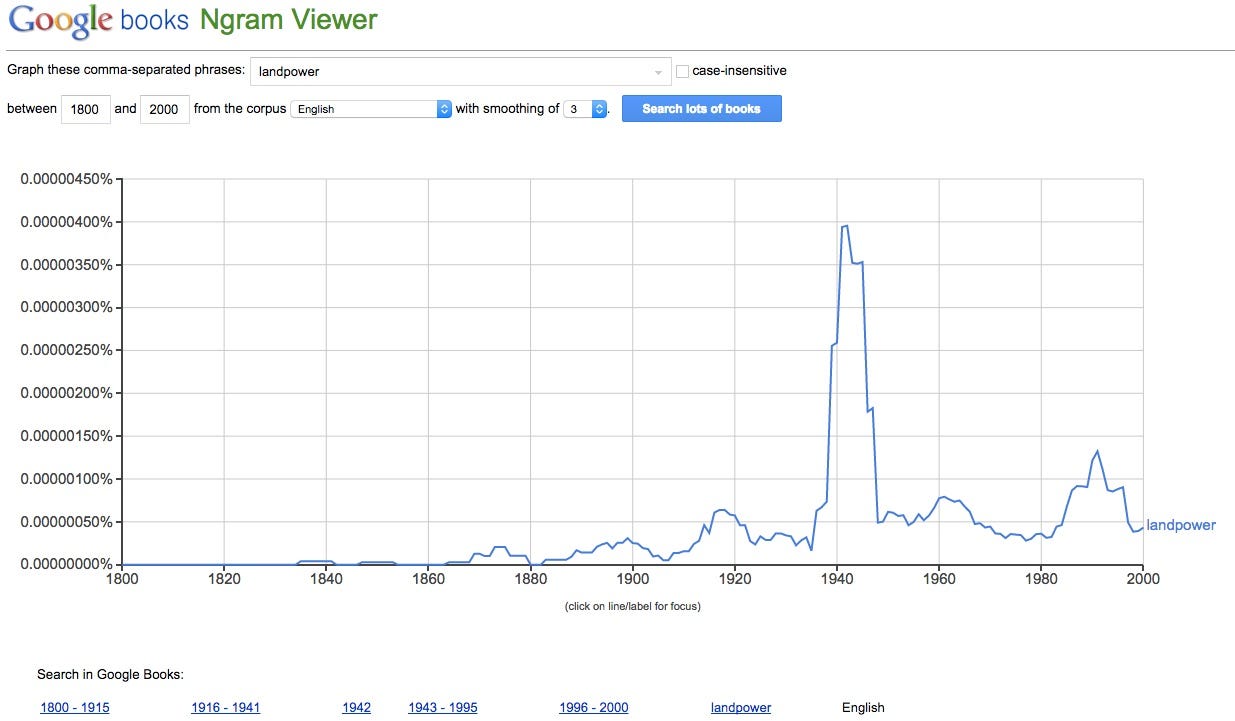 Google analytics on the use of the word “landpower” in books. Use of the word “landpower” spikes in periods of crisis and military downturn, highlighting the tendency to chase budgetary influence.
Google analytics on the use of the word “landpower” in books. Use of the word “landpower” spikes in periods of crisis and military downturn, highlighting the tendency to chase budgetary influence.
These flashy appeals are merely a response to a declining trend in force structure and budgetary influence. But political decisions are not the same as losing “sight of the importance of the soldier, and sound strategy” as Oliver suggests. It’s been popular in past historical defense retrenchments to highlight the inadequacies of one form of military power over another, and “Welcome to the Post-Precision World” is more of the same. Such veiled forms of sister-service sniping are why policy makers and our polity grow tired of the incessant interservice strife. Land power advocates and strategists in general are on much better footing if they acknowledge the difference between political circumstance and sound strategic insight.

Policy decisions like a reduction in force structure are not truly a reflection of poor strategy, but merely a political decision made by politicians for political reasons. In these decisions also exist the real or tacit acknowledgment that reduction in land forces is fraught with risk. “[It] is the lot of the strategist to be unhappy with the nature of collective decisionmaking,” according to Adam Elkus, where crossing “the strategy bridge often entails bearing the burden of collective decisionmaking bodies and political entities that aggregate the desires of various stakeholders in a frustrating and sometimes counterproductive manner.” With this in mind, the suggestion that U.S. land forces are being reduced because of poor strategic insight is unwise, because it equivocates strategy and the nature of war with choices of collective decisionmaking.
But more importantly, the meme of land power’s exceptional discrimination also undermines the truly positive arguments for land power. And many strategists seem to have forgotten how or why the capability of land power, either in fact or latent threat, is truly important. No expansive modern campaign has achieved sufficient strategic advantage without a resolute threat of land power, but it’s an overstatement to say that it is the “central element of military power.” The positive argument for land power is lost when advocates solely focus upon what it is not, as opposed to what it truly accomplishes within the “whole house of war,” whether that is expressed in terms of tactical precision as Oliver does, or more generally in its unique differences from air, sea, space, and cyber power. Swiping at other forms of warfare is still not a positive argument for land power, what it does, and why it is important. To suggest land power as the pinnacle of military force discards joint complement, which empirical examination of warfare does not confirm. Ultimately, the contribution of land power to net strategic effect is just as subject to friction as every other blunt instrument of military might — to suggest otherwise is dangerous.
[1] Everett C Dolman, Pure Strategy: Power and Policy in the Space and Information Age, Cass Series: Strategy and History (London: Routledge, 2005), 5; Carl von Clausewitz, On War, trans. and ed. Michael Howard and Peter Paret (Princeton, N.J.: Princeton University Press, 1989), 128.
[2] Daniel Grazier, “Heisenberg and Mao Zedong: The Occupier Effect,”Medium, accessed December 7, 2014,https://medium.com/@danielgrazier/heisenberg-and-mao-zedong-the-occupier-effect-487244e9769e.
[3] Martin. Windrow, The Last Valley: Dien Bien Phu and the French Defeat in Vietnam (Cambridge, MA: Da Capo Press, 2006), 100–101.
[4] Barry D. Watts, Clausewitzian Friction and Future War, Revised, McNair Paper 68 (Washington, D.C.: Institute for National Security Studies, National Defense University, 2004), 79,http://www.au.af.mil/au/awc/awcgate/ndu/mcnair52.pdf.
No comments:
Post a Comment